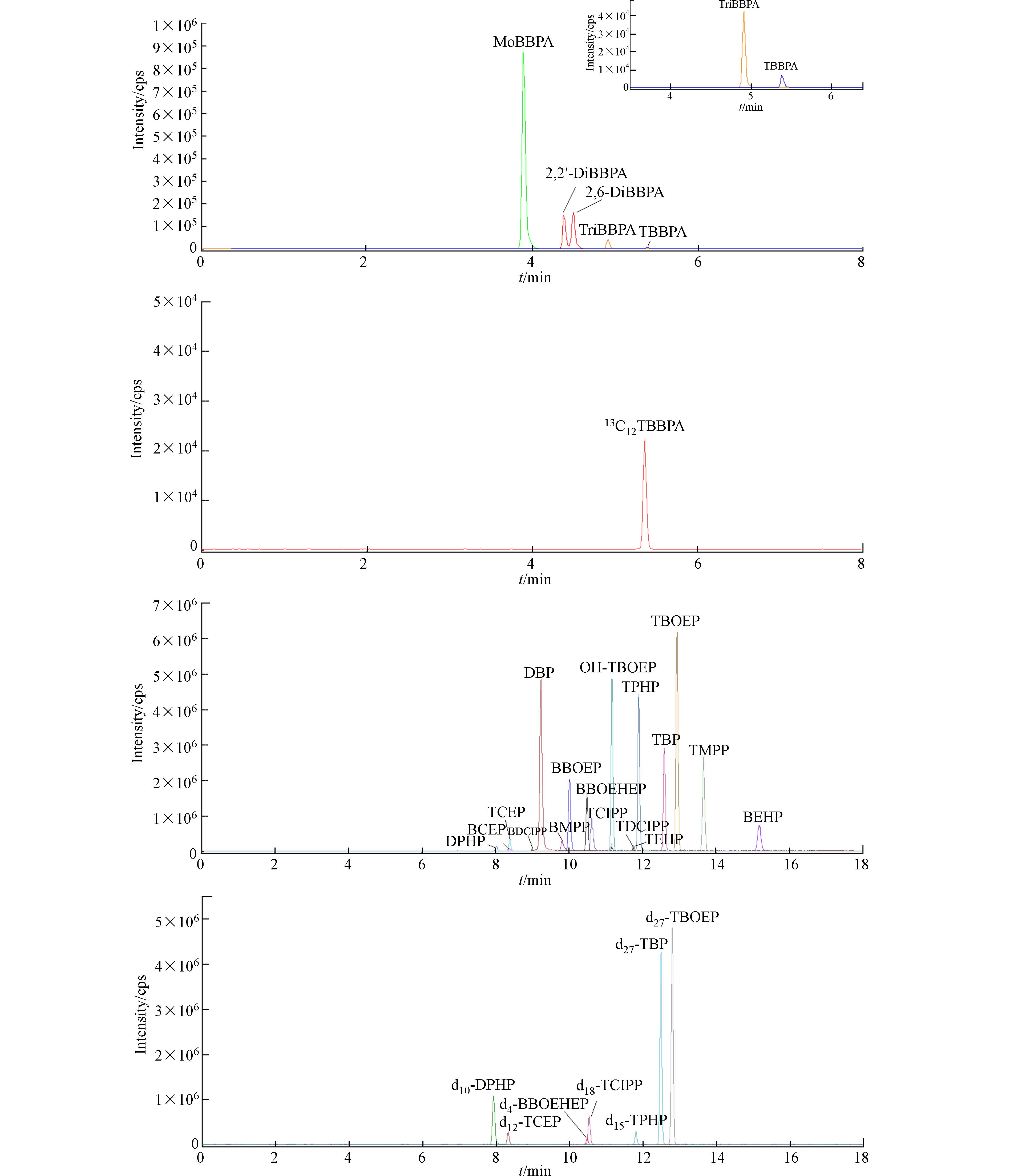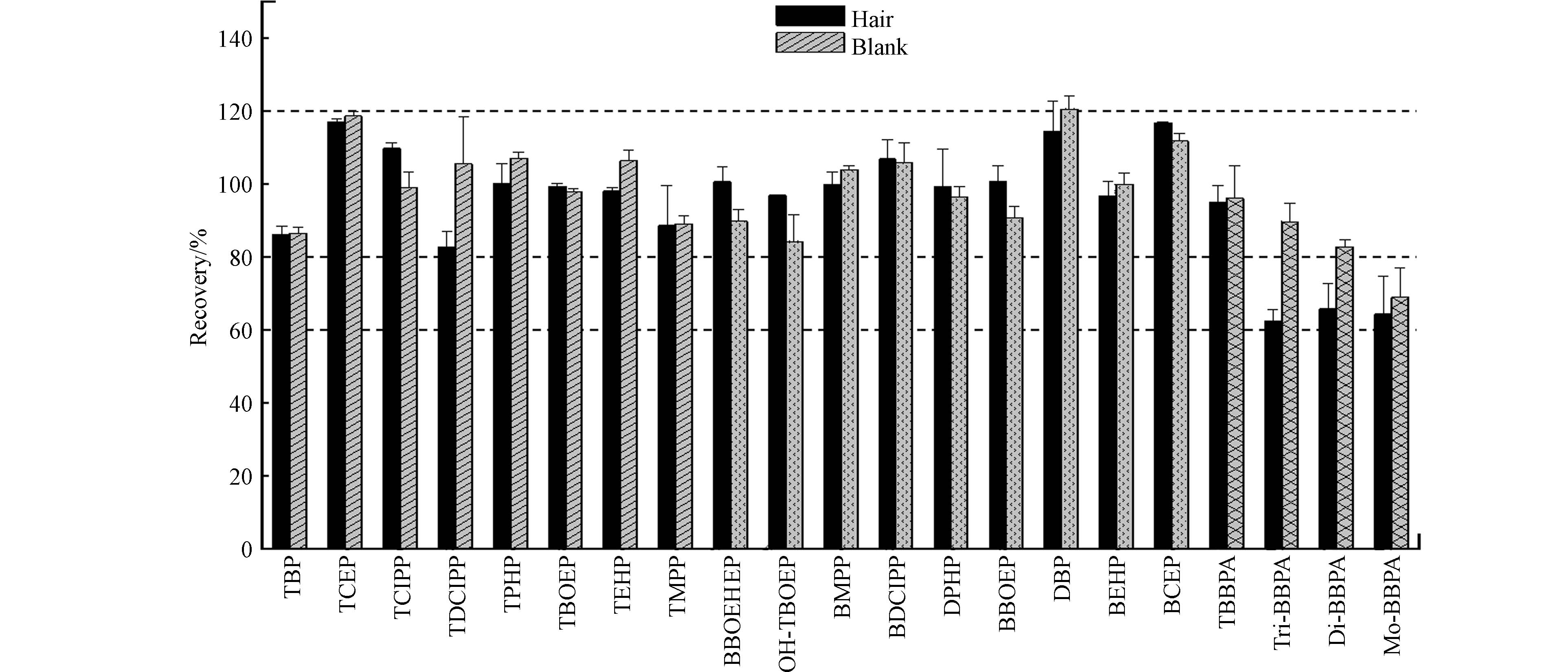-
新污染物是指具有一定的生物毒性和环境持久性,来源复杂多样并且尚未有完善的法规来管控的物质[1 − 2]. 阻燃剂作为一类典型新污染物,由于其具有较强的环境持久性和生物毒性,引起了全球范围内的广泛关注[3 − 5]. 中国2019年四溴双酚A(tetrabromobisphenol A, TBBPA)的年产量约为18万吨,预计2019年至2023年这一数值将以约3.8%的复合年增长率增长[6]. 而随着多溴联苯醚(PBDEs)等典型的溴系阻燃剂在全球范围内被禁用,有机磷阻燃剂(organophosphates, OPEs)作为替代品使用量大幅度上升,全球产量从2001年的16.8万吨增长至2018年的100万吨[7],我国的消费量也从2014年的14.2万吨到2020年的29.4万吨[8 − 9]. 随着TBBPA和OPEs的广泛使用[10],各类环境介质和人体样本中均可检测到此类污染物[11 − 13].
TBBPA和OPEs作为目前仍在大量使用的阻燃剂[14 − 15],已被证实具有包括神经毒性、生殖毒性和内分泌干扰在内的多种毒性效应[16 − 18]. 研究表明,TBBPA和OPEs在血液、尿液等人体样本中被广泛检出[19 − 20],例如Ho等[21]报道了香港人群血浆和尿液中TBBPA的平均浓度分别为3.65 ng·g−1和190 ng·g−1;Li等报道了石家庄市成年人群血液中TCIPP和TEHP平均浓度分别为20.2 ng·mL−1和11.2 ng·mL−1[22]. 此外,有研究表明TBBPA和OPEs进入人体后会发生代谢转化[23],Hou等发现人群血液和尿液中OPEs代谢产物的含量均显著高于其母体化合物,所有的尿液样本中检测到的代谢产物的浓度均高于全血中对应母体的浓度[24]. Nakao等[25]的研究报道了日本母乳样品中Tri-BBPA的浓度是TBBPA浓度的2.9倍. 因此,仅检测母体化合物很可能大幅低估了TBBPA和OPEs的人体暴露风险.
长期以来,血液和尿液等体液样品被广泛应用于环境污染物的人体暴露生物监测. 然而,由于血液在样品采集、保存和运输等方面存在较高要求,对儿童等敏感人群的采样尤为困难,难以应用于大规模人群暴露评估[26],而尿液通常只能反映24 h内的暴露情况[27 − 28],使得用血液和尿液进行环境污染物的暴露监测具有一定的局限性[29]. 为此,近年来发展了头发作为污染物人体暴露生物监测的替代材料,与血液、尿液相比,头发具有采样便捷、便于运输和保存,特别是能够反映较长时间内生理代谢状态等显著优势,已被成功用于多种有机污染物的暴露监测[26, 30 − 32]. 然而,现有对头发中新污染物的研究主要集中于母体化合物,对于代谢产物的研究报道较为有限. 例如,Tang等[33]建立了一种头发中BFRs和PFRs同步分析检测方法,将水浴消解后的头发进行液液萃取,再用Florisil® ENVI 小柱(500 mg,3 mL)进行富集洗脱,氮吹复溶后上机检测,表明头发可以用于此类污染物的暴露监测. 然而,该研究未将代谢产物纳入监测范围,由于研究已证实人体内母乳和尿液中TBBPA和OPEs代谢产物的含量高于母体化合物[24 − 25]. 因此有必要开发高效的头发中TBBPA和OPEs及其代谢产物的联合分析检测方法,以准确评估人群的共暴露风险.
-
离心管(目盛付, 日本),称量纸(上海伯奥生物科技, 中国),玻璃试管(上海安谱实验科技, 中国),棕色进样瓶(上海安谱实验科技, 中国),微量离心管(上海安谱实验科技, 中国),N-丙基乙二胺(PSA)(上海安谱实验科技, 中国),十八烷基硅烷键合硅胶(C18)(上海安谱实验科技, 中国),玻璃巴斯德吸管(Witeg Labortechnik GmbH, 德国),尼龙滤膜(上海安谱实验科技, 中国),AB SCIEX API
6500 三重四极杆质谱仪(AB SCIEX, 美国),液相色谱柱Infinitylab Poroshell 120EC-C18(4.6 mm×100 mm, 2.7 μm)(安捷伦, 美国),真空冷冻干燥机(SP Scientifi, 美国),KQ-500DE型数控超声波清洗器(昆山市超声仪器有限公司, 中国),氮吹仪(Organomation, 美国),分析天平(上海安亭电子仪器厂, 中国),Milli-Q超纯水系统(默克, 德国),涡旋振荡器(Troemner, 美国),离心机(湘仪离心机仪器有限公司, 中国),Eppendorf5810 低速冷冻离心机(Eppendorf, 比利时). -
分析过程中使用的溶剂均为色谱级,乙腈(ACN)、甲醇(MeOH)、正己烷(HEX)和二氯甲烷(DCM)(默克, 德国),乙酸乙酯(EtAC)、甲苯(TL)、丙酮(ACE)、甲基叔丁基醚(MTBE)和甲酸(HCOOH)(上海安谱实验科技, 中国),十二烷基硫酸钠(Sodium dodecyl sulfate, SDS)(科密欧, 中国).
标准品: TBBPA、Σ8OPEs(TBP、TCEP、TCIPP、TDCIPP、TPHP、TBOEP、TEHP和TMPP)、Σ9mOPEs(BBOEHEP、OH-TBOEP、BCEP、BMPP、BDCIPP、DPHP、DBP、BBOEP和BEHP)(AccuStandard, 美国),Tri-BBPA、Di-BBPA和Mo-BBPA由广东工业大学提供;内标:13C12TBBPA、d27-TBOEP、d27-TBP、d12-TCEP、d18-TCIPP、d15-TPHP、d4-BBOEHEP、d10-DPHP(CIL, 美国),详细信息见表1.
-
以陕西神木近期未对头发进行过染烫处理的男性作为研究对象,用丙酮清洗过的不锈钢剪刀在贴近头皮处剪取干燥的头发,原则上头发长度大于2 cm,便于称量,每份样品重量不少于2 g,将采好的头发样品用锡箔纸包裹并装入密实袋中,放置于-20 ℃冰箱保存,待处理.
样品前处理参考Tang[33]、Qin等[34]的研究,样品处理前,将采取的头发样品用0.1%的SDS溶液清洗,将头发样品放置于特氟龙离心管内,加入SDS溶液浸没样品,摇床40 ℃、220 r·min−1清洗1 h,超声30 min,再将头发移至另一干净离心管中用超纯水重复上述步骤两次. 再将头发样品取出平铺在锡箔纸上,放置通风橱,用ACE和HEX分别淋洗1次,盖上锡箔纸,扎孔透气,放置过夜.
实验前用HEX和DCM冲洗过的不锈钢剪刀将头发剪碎至2—3 mm,取0.1 g每份至玻璃离心管,记录每次称量重量,加入浓度为200 ng·mL−1的TBBPA和OPEs及其代谢产物的同位素内标混合液20 μL,用锡箔纸包裹放置通风处过夜. 分别以4 mL MeOH、3 mL MeOH、3 mL ACN、2 mL MeOH作为萃取剂,2000 r·min−1涡旋10 min,20 ℃条件下超声30 min,
3500 r·min−1离心10 min,重复4次,合并上清液至玻璃试管中. 将上清液混合后用温和的氮气吹至1.5 mL,转移至2 mL微量离心管中,加入分散剂(PSA和C18各100 mg),1000 r·min−1涡旋5 min,在5 ℃、10000 r·min−1条件下离心10 min,取上清液至进样瓶中,再加1 mL MeOH于微量离心管中,重复上述操作,合并上清液于进样瓶中,用温和的氮气吹至近干,用200 μL甲醇水(7:3,V/V)混合溶液定容,涡旋后放置于-20 ℃下4—6 h冷冻沉淀去除杂质,取上清液进行HPLC-MS/MS仪器分析. -
TBBPA和OPEs及其代谢产物均采用HPLC-MS/MS进行分析,色谱柱为Infinitylab Poroshell 120EC-C18(4.6 mm×100 mm, 2.7 μm). OPEs和mOPEs:流动相A为甲醇水(5:95,V/V),流动相B为甲醇水(95:5,V/V). 洗脱梯度时间共计18 min:0—0.1 min,35%B;0.1—9 min,95%B;9—13 min,100%B;13—14 min,100%B;14—15 min,35%B;15—18 min,35%B. 流速为0.35 mL·min−1,柱温为45 ℃,进样量为10 μL. 质谱条件采用正负离子交替扫描模式,离子喷雾电压为
4500 V,离子源温度为500 ℃. TBBPA及其脱溴产物:流动相B为乙腈,流动相A为0.1%乙酸水溶液. 洗脱梯度时间共计7.5 min:0 min,60%B;0—2 min,95%B;2—6 min,95%B;6—6.5 min,60%B;6.5—7.5 min,60%B. 流速为0.45 mL·min−1,柱温为40 ℃,进样量为5 μL. 采用负离子扫描模式,离子喷雾电压为4500 V,离子源温度为500 ℃. TBBPA和OPEs及其代谢产物的质谱信息见表2,TBBPA和OPEs及其代谢产物总离子流色谱图见图1. -
分析结果中,所有目标物矫正的回归曲线中决定系数(R2)均>0.995. 实验中所用的玻璃器材均使用碱液(pH>11)浸泡8 h以上,再用自来水和超纯水冲洗3遍,烘干后用马弗炉在450 ℃条件下焙烧6 h以上,使用前用HEX和DCM润洗一遍. 方法定量限(limit of quantification, LOQ)和方法检出限(limit of detection, LOD)为空白样品中目标物浓度的平均值加10倍或者3倍标准差,空白未有物质检出时定义为10倍或者3倍信噪比. 实验采用内标定量法,设置基质、基质加标、空白和空白加标实验组,每组设置3个平行样,目标物回收率范围为80%—120%,相对标准偏差(RSD)<20%.
-
在已发表的实验研究中,Li[35]、Nguyen[36]、Zhou等[37 − 38]使用MeOH、ACN、TL、EtAC、MTBE作为新型有机污染物(emerging organic contaminants, EOCs)前处理方法中的萃取试剂,本实验在已有的实验方案基础上,按照萃取剂极性的不同对萃取剂进行组合和改进,设计6种萃取方案,采用“1.3节”中的样品前处理方法,对头发样品进行处理,具体方案见表3.
OPEs在方案A和方案B的处理下均有良好的检出效果,基质加标回收率介于83.71%—132.75%,但其代谢产物的基质加标回收率除BCEP外均低于60%,代谢产物的损失率较为严重. 在方案C的处理下,将混合溶液萃取换为单一溶液分步萃取,除BEHP基质加标回收率仍低于60%外,BMPP、BDCIPP、BBOEP等代谢产物的基质加标回收率提升至100%—120%,且OPEs的基质加标回收率未有明显变化. 方案D和方案E中采用MeOH、ACN混合溶液提取,加入0.1%的HCOOH溶液调节离子化稳定程度,BEHP的基质加标回收率提升至110%;在方案F中采用MeOH和ACN分步萃取,BDCIPP、DPHP、BBOEP、DBP、BEHP物质的基质加标回收率达到97.88%—119.74%,详情见图2.
在D、E两种方案中,MeOH含量的提升对代谢产物的提取有显著效果,考虑到HCOOH可能对亲水性较强的mOPEs产生基质效应,本研究对F方案进行了调整,去除了HCOOH,并采用2 mL MeOH进行第4次萃取. 同时,对比了在使用分散固相萃取剂进行净化处理后,有机尼龙滤膜对OPEs及其代谢产物回收率的影响. 结果显示,不使用有机滤膜过滤的条件下,TDCIPP、TEHP、DPHP、BBOEHEP、BBOEP、DBP的基质加标回收率均得到明显改善,回收率范围为82.75%—117.12%,RSD介于0.19%—10.99%. 将调整后的方案同时处理TBBPA及其代谢产物,得到基质加标回收率为62.28%—95.10%,RSD为5.12%—16.23%,详情见图3.
-
本实验采用内标法对目标物质进行定量分析,将目标化合物及内标溶于MeOH配制混合标准溶液,TBBPA及其代谢产物稀释为0.5、1、2、5、10、20、50、100 ng·mL−1等8个浓度梯度,OPEs及其代谢产物混合溶液稀释为0.5、1、5、10、20、50、100、200 ng·mL−18个浓度梯度,所有配制的标准曲线在仪器最佳条件下进行检测. 回归方程中各决定系数(R2)均大于0.995,以保证各目标物在浓度梯度范围内具有良好的线性关系. 按照“1.5节”中方法来计算目标物质的定量限和检出限,TBBPA和代谢产物的检出限浓度范围为0.084—0.202 ng·g−1,OPEs和代谢产物的检出限浓度范围为0.002—7.189 ng·g−1,详情见表4.
-
所测目标化合物的基质加标回收率用来验证所测得数据的准确性,各平行样品之间的RSD用来验证所测得数据的精密度. 经过前处理方法的优化,采取MeOH 4 mL、MeOH 3 mL、ACN 3 mL、MeOH 2 mL分步萃取,加入分散固相萃取剂200 mg(PSA:C18,1:1),测得头发中TBBPA及其代谢产物的基质加标回收率范围为62.28%—95.10%,RSD为5.12%—16.23%,OPEs及其代谢产物的基质加标回收率范围为82.75%—117.12%,RSD为0.19%—10.99%,说明此前处理方法适用于头发中TBBPA和OPEs及其代谢产物的同步分析.
-
将本实验建立的TBBPA和OPEs及其代谢产物的同步分析检测方法用于检测陕西神木普通人群10名男性真实头发样本,结果显示,TBBPA的检出率为100%,平均浓度为7.10 ng·g−1,脱溴产物Mo-BBPA检出率为10%,Tri-BBPA和Di-BBPA均未检出;17种OPEs及其代谢产物均有检出,Σ8OPEs的浓度范围在184—843 ng·g−1,其中TDCIPP和TEHP浓度最高,中值分别为69.4 ng·g−1和83.4 ng·g−1;Σ9mOPEs的浓度范围在76.7—191 ng·g−1,其中BEHP浓度最高,平均值为40.5 ng·g−1,详情见表5. 与乔琳[39]等研究结果一致,TCIPP、TDCIPP、TPHP、TEHP为头发样品中检出浓度较高的有机磷阻燃剂,而TBOEP的检出浓浓度与广州市普通居民头发中的检出浓度一致[40].
-
本研究在已有研究的基础上,建立了4 mL MeOH、3 mL MeOH、3 mL ACN、2 mL MeOH分步超声提取,实现了对人体头发中TBBPA和OPEs及其代谢产物的同步提取,所有目标污染物的回收率范围为62.28%—117.12%,RSD介于0.19%—16.23%之间,检出限浓度范围为0.002—7.189 ng·g−1. 此研究方法简单便捷,检出限低,重现性好,对识别TBBPA和OPEs及其代谢产物在人体内的代谢途径和健康影响具有重要意义.
头发中四溴双酚A和有机磷酸酯及其代谢产物的同步分析检测方法
Method for simultaneous analysis and detection of tetrabromobisphenol A and organophosphates and their metabolites in hair
-
摘要: 头发作为有机污染物人体暴露生物检测材料,具有采样无创伤、易运输储存,并且可以反映长期或慢性暴露的优点,已被广泛用于多种有机污染物的人体暴露评估. 然而,目前少有研究同时对头发中的有机污染物及其代谢产物进行同步分析检测,大大低估了有机污染物的人体暴露风险. 本研究基于固相萃取和高效液相色谱串联质谱法(HPLC-MS/MS)建立了头发中四溴双酚A(Tetrabromobisphenol A,TBBPA)和有机磷酸酯(Organophosphates,OPEs)及其代谢产物的分析检测方法. 头发样品采用甲醇、乙腈分步超声提取,使用100 mg N-丙基乙二胺(PSA)和100 mg十八烷基硅烷键合硅胶(C18)净化后,采用HPLC-MS/MS在多重反应监测模式(MRM)下对目标化合物进行定量分析. 所有目标化合物在设定浓度范围内线性良好,决定系数R2>0.995,回收率范围介于62.28%—117.12%,相对标准差在0.19%—16.23%之内,检出限范围为0.001—7.189 ng·g−1. 采用本方法对陕西神木人群头发样本中TBBPA及其3种脱溴产物和8种OPEs及其9种代谢产物进行检测分析,TBBPA的检出率为100%,中值浓度为1.99 ng·g−1,脱溴产物Mo-BBPA检出率为10%,Tri-BBPA和Di-BBPA均未检出. 17种OPEs及其代谢产物均有检出,Σ8OPEs的浓度范围在184—843 ng·g−1,其中TDCIPP和TEHP浓度最高,中值分别为69.4 ng·g−1和83.4 ng·g−1;Σ9mOPEs的浓度范围在76.7—191 ng·g−1,其中BEHP浓度最高,中值为40.5 ng·g−1. 本研究成功建立了一种便捷可靠的头发中TBBPA和OPEs及其代谢产物的检测方法,为开展人体典型新污染物的长期暴露评估提供了技术支撑.
-
关键词:
- 溴代阻燃剂 /
- 磷系阻燃剂 /
- 代谢产物 /
- 头发 /
- 高效液相色谱串联质谱法.
Abstract: Hair has been widely used as biomonitoring tool for human exposure to environmental pollutants, with the advantages of non-invasive sampling, easy transportation and storage, and reflecting long-term or chronic exposure. However, limited studies have reported simultaneous analysis of organic pollutants and their metabolites in human hair, which may underestimate their exposure risks. In this study, a method for the simultaneous analysis of tetrabromobisphenol A (TBBPA) and organophosphate esters (OPEs) as well as their metabolites in human hair was established based on solid phase extraction (SPE) and high performance liquid chromatography tandem mass spectrometry (HPLC-MS/MS). Hair samples were extracted by methanol and acetonitrile, purified by 100 mg primary secondary amine (PSA) and 100 mg octadecyl bonded silica (C18), and quantitatively analyzed by HPLC-MS/MS in multiple reaction monitoring mode (MRM). All the target compounds had good linearities within the set concentration range with the determination coefficient (R2) > 0.995. The recoveries of the target compounds ranged from 62.3% to 117.1% with the relative standard deviation (RSD) of 0.19%—16.23%, and the limit of detection (LOD) were from 0.001 ng·g−1 to 7.189 ng·g−1. The established method was used to detect TBBPA and 3 debrominated products as well as 8 OPEs and 9 metabolites in human hair collected from general population in Shenmu county, Shaanxi Province. The detection frequency of TBBPA was 100% and the median concentration was 1.99 ng·g−1. The detection frequency of Mo-BBPA was 10%, while neither Tri-BBPA nor Di-BBPA was detected. Seventeen OPEs and their metabolites were detected in human hair with the concentrations of Σ8OPEs and Σ9mOPEs were in the ranges of 184—843 ng·g−1 and 76.7—191 ng·g−1, respectively. TDCIPP and TEHP were the predominant compounds for OPEs with the median values of 69.4 ng·g−1 and 83.4 ng·g−1, respectively, while BEHP was detected at the highest concentration for mOPEs with the median value of 40.5 ng·g−1. This study successfully established a convenient and reliable method for the simultaneous analysis of TBBPA and OPEs and their metabolites in human hair, which could provide technical support for the long-term exposure risk assessment of emerging pollutants.-
Key words:
- brominated flame retardants /
- organophosphate esters /
- metabolites /
- hair /
- HPLC-MS/MS.
-
表 1 TBBPA、OPEs及其代谢产物基本信息
Table 1. Basic information of TBBPA, OPEs and their metabolites
中文全称Full Chinese name 英文简称English abbreviation 英文全称Full English name CAS号 对应内标Corresponding internal standard 四溴双酚A TBBPA Tetrabromobisphenol A 21850 -44-213C12TBBPA 三溴双酚A Tri-BBPA Tribromobisphenol A 6386 -73-813C12TBBPA 二溴双酚A Di-BBPA Dibromobisphenol A 29426 -78-613C12TBBPA 一溴双酚A Mo-BBPA Monobromobisphenol A 6073 -11-613C12TBBPA OPEs 磷酸三丁酯 TBP Tributyl phosphate 126-73-8 d27-TBP 磷酸三(2-氯乙基)酯 TCEP Tris(2-chloroethyl) phosphate 115-96-8 d12-TCEP 磷酸三(2-氯丙基)酯 TCIPP Tris(1-chloro-2-propyl) phosphate 13674 -84-5d18-TCIPP 磷酸三(1,3-二氯异丙基)酯 TDCIPP Tris(1,3-dichloro-2-propyl) phosphate 13674 -87-8d18-TCIPP 磷酸三苯酯 TPHP Triphenyl phosphate 115-86-6 d15-TPHP 磷酸三(2-丁氧乙基)酯 TBOEP Tris(2-butoxyethyl) phosphate 78-51-3 d27-TBOEP 磷酸三(2-乙基己基)酯 TEHP Tris(2-ethylhexyl) phosphate 78-42-2 d18-TCIPP 磷酸三甲酯 TMPP trimethyl phosphate 512-56-1 d18-TCIPP 2-羟乙基双(2-丁氧基乙基)磷酸酯 BBOEHEP 2-hydroxyethyl bis(2-butoxyethyl) phosphate 1477494 -86-2d4-BBOEHEP 磷酸二(2-丁氧乙基)2-(3-羟基丁氧基)乙基酯 OH-TBOEP Bis-(2-butoxyethyl) hydroxy-2-butoxyethyl phosphate 1477494 -87-3d27-TBOEP 双(2-氯乙基)磷酸酯 BCEP Di-b,b'-Chloroethylphosphoric acid 3040 -56-0d12-TCEP 磷酸二甲酯 BMPP Dimethyl phosphate 813-78-5 d10-DPHP 双(1,3-二氯-2-丙基) 磷酸酯 BDCIPP Bis(1,3-dichloro-2-propyl) phosphate 72236 -72-7d18-TCIPP 磷酸二苯酯 DPHP Diphenyl phosphate 838-85-7 d10-DPHP 磷酸二丁酯 DBP Dibutyl phosphate 107-66-4 d27-TBP 双(丁氧乙基) 磷酸酯 BBOEP Bis(butoxyethyl) phosphate 4260 -97-0d27-TBP 双(2-乙基己基)磷酸酯 BEHP Bis(2-ethylhexyl) phosphate 298-07-7 d15-TPHP 表 2 TBBPA、OPEs及其代谢产物质谱信息
Table 2. Mass spectra information of TBBPA, OPEs and their metabolites
目标物Compounds 母离子Primary ion 子离子Secondary ion 去簇电压/VDeclustering potential 碰撞能/eVCollision energy 保留时间/minRetention time TBBPA 543 81.0420 −120−120 −60.0−55.0 5.38 Tri-BBPA 465 79.081.0 −101−112 −50.0−55.0 4.92 Di-BBPA 385 79.081.0 −101 −47.0 4.43 Mo-BBPA 307 79.081.0 −91.0−101 −35.0−28.8 3.89 13C12TBBPA 555 460 −110 −47 5.36 OPEs TBP 267 98.7155 92.090.0 20.015.0 12.6 TCEP 287285 63.1223 60.060.0 46.018.0 8.40 TCIPP 327327 25199.0 70.064.6 13.029.8 10.6 TDCIPP 431 209 123 31.0 11.8 TPHP 327327 215152 112102 33.049.4 11.9 TBOEP 339339 199299 75.076.7 21.018.3 13.0 TEHP 435 99.0 81.2 23.4 11.7 TMPP 369369 243165 80.0125 34.059.2 13. 7 BBOEHOP 343 243 40.0 16.0 10.5 OH-TBOEP 415 199 82.0 21.0 11.2 BCEP 223 99.0161 130 18.110.3 8.37 BMPP 277277 107169 −65.0−60.0 −35.0−38.0 9.83 BDCIPP 319 35.0 −42.7 −24.0 9.01 DPHP 249249 93.1155 −77.0−60.0 −36.0 8.04 BEHP 321 20979.0 −102−120 −45.0 15.2 BBOEP 297298 79.079.1 −102−98.8 −32.0−30.9 10.0 DBP 209209 15379.0 −70.0−67.1 −20.0−24.4 9.25 d27−TBOEP 426 208 82 23 12.8 d27−TBP 294 102166 7075 2818 12.5 d12−TCEP 297 232130 7078 1926 8.34 d15−TPHP 342 82161 114130 5445 11.82 d18−TCIPP 345 102 50 28 10.54 d4−BBOEHEP 347 247 78 21 10.49 d10−DPHP 259 98 −85 −37 7.95 表 3 不同萃取剂组合的6种前处理方案
Table 3. Six different extractants tested for the pretreatment
编号ID 萃取剂Extractant 具体方案Specific scheme A ACN:TL 9:1 萃取3次,分别为4 mL、3 mL、3 mL B EtAC 萃取3次,分别为4 mL、3 mL、3 mL C MeOH、ACN:MTBE 2:1 萃取3次,分别为MeOH 4 mL、ACN:MTBE 2:1 3 mL、ACN:MTBE 2:1 3 mL D MeOH:ACN 95:5(含0.1% HCOOH) 萃取3次,分别为4 mL、3 mL、3 mL E MeOH:ACN 5:95(含0.1% HCOOH) 萃取3次,分别为4 mL、3 mL、3 mL F MeOH(含0.1% HCOOH)、ACN(含0.1% HCOOH) 萃取3次,MeOH 4 mL、CAN 3 mL、MeOH 3 mL 表 4 TBBPA、OPEs及其代谢产物的LOQs及LODs
Table 4. LOQs and LODs of TBBPA, OPEs and their metabolites
目标物Compounds 决定系数R2 定量限/(ng·g−1)LOQ 检出限/(ng·g−1)LOD TBBPA 0.999 0.252 0.084 Tri-BBPA 0.998 0.606 0.202 Di-BBPA 0.996 0.574 0.172 Mo-BBPA 0.998 0.503 0.151 OPEs TBP 0.999 8.944 2.981 TCEP 0.998 14.578 4.859 TCIPP 0.999 9.001 3.000 TDCIPP 0.998 4.388 1.463 TPHP 0.998 0.931 0.310 TBOEP 0.999 0.007 0.002 TEHP 0.999 0.152 0.051 TMPP 0.996 0.056 0.019 BBOEHOP 0.998 0.068 0.023 OH-TBOEP 0.998 0.006 0.002 BCEP 0.998 21.566 7.189 BMPP 0.998 0.002 0.001 BDCIPP 0.997 0.266 0.089 DPHP 0.998 2.323 0.774 BEHP 0.998 2.727 0.909 BBOEP 0.999 0.109 0.036 DBP 0.999 2.750 0.917 表 5 头发样品中TBBPA和OPEs及其代谢产物的检出率及浓度范围
Table 5. Detection frequencies and concentration ranges of TBBPA and OPEs and their metabolites in hair samples
目标物Compounds 实际样品检测数量/个The actual number of samples tested 检出率/%Detection frequency 浓度范围/(ng·g−1)Concentration range 浓度均值/(ng·g−1)Concentration average 浓度中值/(ng·g−1)Concentration median TBBPA 10 100 0.09—44.9 7.10 1.99 Tri-BBPA 0 nd nd nd Di-BBPA 0 nd nd nd Mo-BBPA 10 nd—79.9 7.99 nd ∑4XBBPA 50 0.09—84.9 15.1 1.99 OPEs 10 TBP 100 3.40—27.0 10.02 8.40 TCEP 100 3.96—39.9 18.7 16.5 TCIPP 100 23.1—144 79.8 89.3 TDCIPP 100 5.08—287 94.5 69.4 TPHP 100 28.6—150 71.8 51.7 TBOEP 100 2.18—326 36.8 4.70 TEHP 100 44.0—172 93.0 83.4 TMPP 80 nd—16.7 5.09 3.25 ∑8OPEs 100 184—843 410 387 mOPEs 10 BBOEHOP 30 nd—7.03 1.00 nd OH-TBOEP 50 nd—11.7 1.65 0.32 BCEP 100 6.8—69.1 34.3 31.7 BMPP 20 nd—0.23 0.025 nd BDCIPP 70 nd—31.2 6.27 0.36 DPHP 80 4.48—42.2 20.1 20.0 BEHP 100 16.3—134 45.8 40.5 BBOEP 100 nd—3.09 0.35 0.028 DBP 100 5.15—30.0 15.6 15.7 ∑9mOPEs 100 76.7—191 125 111 注:nd 未检出. Note: nd, not detected. -
[1] GARCÍA J, GARCÍA-GALÁN M J, DAY J W, et al. A review of emerging organic contaminants (EOCs), antibiotic resistant bacteria (ARB), and antibiotic resistance genes (ARGs) in the environment: Increasing removal with wetlands and reducing environmental impacts[J]. Bioresource Technology, 2020, 307: 123228. doi: 10.1016/j.biortech.2020.123228 [2] ZHONG M M, WANG T L, ZHAO W X, et al. Emerging organic contaminants in Chinese surface water: Identification of priority pollutants[J]. Engineering, 2022, 11: 111-125. doi: 10.1016/j.eng.2020.12.023 [3] FU M R, QIAO Z H, ZHOU S Q, et al. Five coexisting brominated flame retardants in a water-sediment-Vallisneria system: Bioaccumulation and effects on oxidative stress and photosynthesis[J]. Science of the Total Environment, 2024, 933: 173230. doi: 10.1016/j.scitotenv.2024.173230 [4] LALLMAHOMED A, MERCIER F, COSTET N, et al. Characterization of organic contaminants in hair for biomonitoring purposes[J]. Environment International, 2024, 183: 108419. doi: 10.1016/j.envint.2024.108419 [5] LIU B L, DING L J, LV L Y, et al. Organophosphate esters (OPEs) and novel brominated flame retardants (NBFRs) in indoor dust: A systematic review on concentration, spatial distribution, sources, and human exposure[J]. Chemosphere, 2023, 345: 140560. doi: 10.1016/j.chemosphere.2023.140560 [6] ZHOU H, YIN N Y, FAIOLA F. Tetrabromobisphenol A (TBBPA): A controversial environmental pollutant[J]. Journal of Environmental Sciences, 2020, 97: 54-66. doi: 10.1016/j.jes.2020.04.039 [7] ZHU H K, AL-BAZI M M, KUMOSANI T A, et al. Occurrence and profiles of organophosphate esters in infant clothing and raw textiles collected from the United States[J]. Environmental Science & Technology Letters, 2020, 7(6): 415-420. [8] ZHANG Y H, ZHAO B, CHEN Q, et al. Fate of organophosphate flame retardants (OPFRs) in the “Cambi® TH + AAD” of sludge in a WWTP in Beijing, China[J]. Waste Management, 2023, 169: 363-373. doi: 10.1016/j.wasman.2023.07.030 [9] ZHENG J, ZHANG S Y, LUO W K, et al. Tracing semi-quantitatively the absorption and removal of organic pollutants in human hair based on secondary ion mass spectrometry[J]. Journal of Hazardous Materials, 2024, 477: 135278. doi: 10.1016/j.jhazmat.2024.135278 [10] WANG X, ZHU Q Q, YAN X T, et al. A review of organophosphate flame retardants and plasticizers in the environment: Analysis, occurrence and risk assessment[J]. Science of the Total Environment, 2020, 731: 139071. doi: 10.1016/j.scitotenv.2020.139071 [11] CHEN Y, XIAN H, ZHU C C, et al. The transport and distribution of novel brominated flame retardants (NBFRs) and organophosphate esters (OPEs) in soils and moss along mountain valleys in the Himalayas[J]. Journal of Hazardous Materials, 2024, 465: 133044. doi: 10.1016/j.jhazmat.2023.133044 [12] HU Q P, ZENG X Y, XIAO S Y, et al. Co-occurrence of organophosphate diesters and organophosphate triesters in daily household products: Potential emission and possible human health risk[J]. Journal of Hazardous Materials, 2024, 465: 133116. doi: 10.1016/j.jhazmat.2023.133116 [13] WANG T, ZHANG H, HUANG C, et al. Occurrence and potential risks of organophosphate esters in agricultural soils: A case study of Fuzhou City, southeast China[J]. Journal of Environmental Sciences, 2025, 150: 571-581. doi: 10.1016/j.jes.2024.03.005 [14] LI Z R, LI Z C, ZHOU Y, et al. Co-occurrence of tetrabromobisphenol a and debromination products in human hair across China: Implications for exposure sources and health effects on metabolic syndrome[J]. Science of the Total Environment, 2024, 909: 168514. doi: 10.1016/j.scitotenv.2023.168514 [15] YU Y J, GUO H B, ZHONG Z J, et al. Enhanced removal of tetrabromobisphenol A by Burkholderia cepacian Y17 immobilized on biochar[J]. Ecotoxicology and Environmental Safety, 2023, 249: 114450. doi: 10.1016/j.ecoenv.2022.114450 [16] HOGBERG H T, de CÁSSIA Da SILVEIRA E SÁ R, KLEENSANG A, et al. Organophosphorus flame retardants are developmental neurotoxicants in a rat primary brainsphere in vitro model[J]. Archives of Toxicology, 2021, 95(1): 207-228. doi: 10.1007/s00204-020-02903-2 [17] LIU A F, ZHAO Z S, QU G B, et al. Transformation/degradation of tetrabromobisphenol A and its derivatives: A review of the metabolism and metabolites[J]. Environmental Pollution, 2018, 243: 1141-1153. doi: 10.1016/j.envpol.2018.09.068 [18] 廖梓聪, 李会茹, 杨愿愿, 等. 有机磷酸酯(OPEs)的环境污染特征、毒性和分析方法研究进展[J]. 环境化学, 2022, 41(4): 1193-1215. doi: 10.7524/j.issn.0254-6108.2020121601 LIAO Z C, LI H R, YANG Y Y, et al. The pollution characteristics, toxicity and analytical methods of organophosphate esters(OPEs) in environments: A review[J]. Environmental Chemistry, 2022, 41(4): 1193-1215 (in Chinese). doi: 10.7524/j.issn.0254-6108.2020121601
[19] LIU L Y, SALAMOVA A, HE K, et al. Analysis of polybrominated diphenyl ethers and emerging halogenated and organophosphate flame retardants in human hair and nails[J]. Journal of Chromatography A, 2015, 1406: 251-257. doi: 10.1016/j.chroma.2015.06.003 [20] WANG S F, LING X H, WU X, et al. Release of tetrabromobisphenol A (TBBPA)-derived non-extractable residues in oxic soil and the effects of the TBBPA-degrading bacterium Ochrobactrum sp. strain T[J]. Journal of Hazardous Materials, 2019, 378: 120666. doi: 10.1016/j.jhazmat.2019.05.059 [21] HO K L, YUEN K K, YAU M S, et al. Glucuronide and sulfate conjugates of tetrabromobisphenol A (TBBPA): Chemical synthesis and correlation between their urinary levels and plasma TBBPA content in voluntary human donors[J]. Environment International, 2017, 98: 46-53. doi: 10.1016/j.envint.2016.09.018 [22] LI Y B, LV Y, JIANG Z X, et al. Association of co-exposure to organophosphate esters and per- and polyfluoroalkyl substances and mixture with cardiovascular-kidney-liver-metabolic biomarkers among Chinese adults[J]. Ecotoxicology and Environmental Safety, 2024, 280: 116524. doi: 10.1016/j.ecoenv.2024.116524 [23] WANG X, ZHU Q Q, LIAO C Y, et al. Human internal exposure to organophosphate esters: A short review of urinary monitoring on the basis of biological metabolism research[J]. Journal of Hazardous Materials, 2021, 418: 126279. doi: 10.1016/j.jhazmat.2021.126279 [24] HOU M M, SHI Y L, JIN Q, et al. Organophosphate esters and their metabolites in paired human whole blood, serum, and urine as biomarkers of exposure[J]. Environment International, 2020, 139: 105698. doi: 10.1016/j.envint.2020.105698 [25] NAKAO T, AKIYAMA E, KAKUTANI H, et al. Levels of tetrabromobisphenol A, tribromobisphenol A, dibromobisphenol A, monobromobisphenol A, and bisphenol a in Japanese breast milk[J]. Chemical Research in Toxicology, 2015, 28(4): 722-728. doi: 10.1021/tx500495j [26] 于云江, 郑晶, 罗伟铿, 等. 头发作为环境污染物人体暴露生物检测材料的研究进展[J]. 科学通报, 2023, 68(16): 2070-2085. doi: 10.1360/TB-2022-1247 YU Y J, ZHENG J, LUO W K, et al. Hair as a biomonitoring tool of human exposure to environmental pollutants: A review[J]. Chinese Science Bulletin, 2023, 68(16): 2070-2085 (in Chinese). doi: 10.1360/TB-2022-1247
[27] TANG B, ZHENG J, XIONG S M, et al. The accumulation of organic contaminants in hair with different biological characteristics[J]. Chemosphere, 2023, 312: 137064. doi: 10.1016/j.chemosphere.2022.137064 [28] YEASMIN S, AMMANATH G, ONDER A, et al. Current trends and challenges in point-of-care urinalysis of biomarkers in trace amounts[J]. TrAC Trends in Analytical Chemistry, 2022, 157: 116786. doi: 10.1016/j.trac.2022.116786 [29] LI X L, WANG B, LIU F, et al. Occurrence and removal of pharmaceutical contaminants in urine: A review[J]. Water, 2023, 15(8): 1517. doi: 10.3390/w15081517 [30] CHRISTENSEN J R, LaBINE G O, MOLLOY P, et al. Screening for elevated blood lead levels using single hair strands: Accounting for external contamination[J]. Hygiene and Environmental Health Advances, 2023, 8: 100081. doi: 10.1016/j.heha.2023.100081 [31] REN M Y, FANG M L, LIU J, et al. Applying hair exposome for linking environmental exposure to reproductive health: A comprehensive review and research perspective[J]. Hygiene and Environmental Health Advances, 2024, 9: 100086. doi: 10.1016/j.heha.2023.100086 [32] ZHANG S Y, YAN X, TANG B, et al. Human hair as a noninvasive matrix to assess exposure to micro-organic contaminants: State of the art review[J]. Science of the Total Environment, 2023, 892: 164341. doi: 10.1016/j.scitotenv.2023.164341 [33] TANG B, XIONG S M, ZHENG J, et al. Analysis of polybrominated diphenyl ethers, hexabromocyclododecanes, and legacy and emerging phosphorus flame retardants in human hair[J]. Chemosphere, 2021, 262: 127807. doi: 10.1016/j.chemosphere.2020.127807 [34] QIN R X, CAO X, ZHANG S Y, et al. Decontamination promotes the release of incorporated organic contaminants in hair: Novel insights into non-invasive biomonitoring[J]. Environmental Pollution, 2024, 359: 124696. doi: 10.1016/j.envpol.2024.124696 [35] LI W H, WANG Y, ASIMAKOPOULOS A G, et al. Organophosphate esters in indoor dust from 12 countries: Concentrations, composition profiles, and human exposure[J]. Environment International, 2019, 133: 105178. doi: 10.1016/j.envint.2019.105178 [36] NGUYEN K N, SAXENA R, RE D B, et al. Rapid LC-MS/MS quantification of Organophosphate non-specific metabolites in hair using alkaline extraction approach[J]. Journal of Chromatography. B, Analytical Technologies in the Biomedical and Life Sciences, 2023, 1217: 123619. doi: 10.1016/j.jchromb.2023.123619 [37] ZHOU Y, LI Z R, ZHU Y, et al. Legacy and alternative flame retardants in indoor dust from e-waste industrial parks and adjacent residential houses in South China: Variations, sources, and health implications[J]. Science of the Total Environment, 2022, 845: 157307. doi: 10.1016/j.scitotenv.2022.157307 [38] 周颖, 朱钰, 李宗睿, 等. 固相萃取-液相色谱串联质谱(LC-MS/MS)同步测定鸡蛋样品中有机磷酸酯及其代谢产物[J]. 环境化学, 2023, 42(6): 1970-1980. doi: 10.7524/j.issn.0254-6108.2022011001 ZHOU Y, ZHU Y, LI Z R, et al. Simultaneous determination of organophosphate esters and their specific metabolites in egg samples by solid-phase extraction with LC-MS/MS[J]. Environmental Chemistry, 2023, 42(6): 1970-1980 (in Chinese). doi: 10.7524/j.issn.0254-6108.2022011001
[39] QIAO L, ZHENG X B, ZHENG J, et al. Analysis of human hair to assess exposure to organophosphate flame retardants: Influence of hair segments and gender differences[J]. Environmental Research, 2016, 148: 177-183. doi: 10.1016/j.envres.2016.03.032 [40] 黄璐璐, 唐斌, 廖其龙, 等. 广州市普通人群头发中多种有机污染物暴露评估[J]. 环境化学, 2025, 44(4): 1235-1253. doi: 10.7524/j.issn.0254-6108.2023121802 HUANG L L, TANG B, LIAO Q L, et al. Exposure assessment of various organic pollutants in the hair of thegeneral population in Guangzhou City[J]. Environmental Chemistry, 2025, 44(4): 1235-1253(in Chinese). doi: 10.7524/j.issn.0254-6108.2023121802
-





 下载:
下载:



